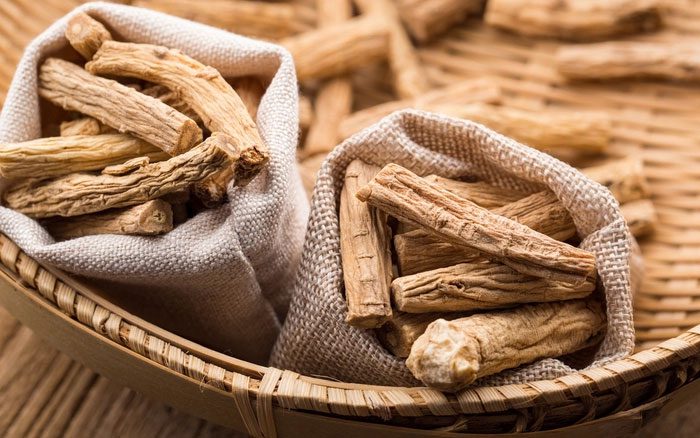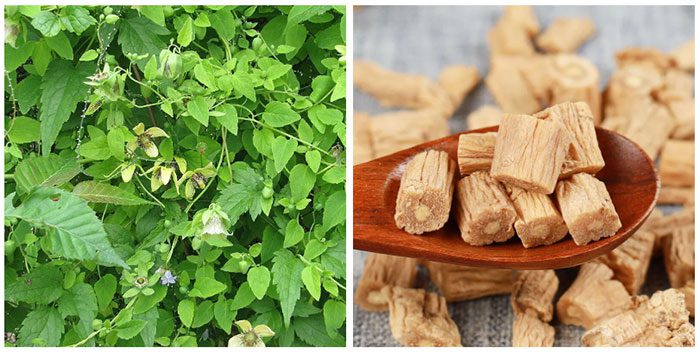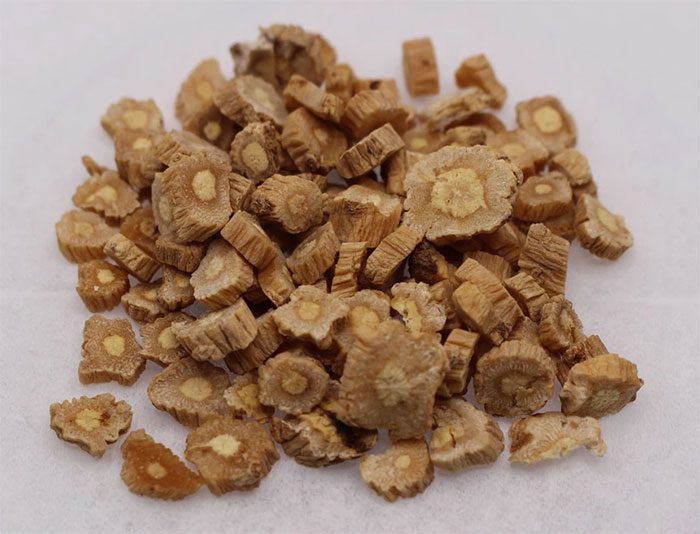Dang Sam, also known as Codonopsis, is referred to by several other names, including Dong Dang Sam, Lo Dang Sam, Xuyen Dang Sam, Dong Dang Sam, and Ray Cay (in Lang Son), among others. Despite lacking the chemical compounds known as saponins that are responsible for some of the effects of ginseng, this herb is often likened to the “ginseng for the poor” due to its numerous health benefits, some of which are similar to those of ginseng.

Dang Sam (also known as Codonopsis).
1. Characteristics of Dang Sam
Dang Sam is a perennial medicinal plant that is a small climbing vine. Its roots are cylindrical, long, and about 1-2 cm in diameter, with the tip of the root swollen. The roots have many raised scars from the old stem. Notably, Dang Sam typically has a single taproot without branching roots, tapering towards the end. When fresh, the roots are white, turning yellow when dried. The roots are the part used for medicinal purposes.
The plant’s stem is purple with sparse hairs, while the tips are hairless. The leaves grow oppositely, alternately, or sometimes in a whorled pattern. Flowers emerge singly in the leaf axils, bell-shaped, and pale yellow. The fruit is a flattened spherical capsule containing numerous seeds.
Phytochemical studies have shown that the main chemical components of Dang Sam include: alkaloids, alkynes, polyacetylenes, flavonoids, lignans, steroids, terpenoids, organic acids, volatile oils, saccharides, and other components.
Additionally, Dang Sam is rich in amino acids, inorganic elements, and trace elements essential for the human body.

Images of fresh and dried Dang Sam. (Photo: Internet).
2. What are the Benefits of Dang Sam?
2.1. According to Traditional Medicine
In traditional medicine, Dang Sam is sweet in taste, neutral in nature, and enters the lung and spleen meridians. This herb acts to harmonize the spleen and stomach, aids digestion, increases vitality, promotes the secretion of body fluids, nourishes the body, and quenches thirst.
Dang Sam is also beneficial for the spleen and lungs. This herb is commonly used to alleviate symptoms of fatigue due to exhaustion, loss of appetite, and diarrhea. Additionally, Dang Sam can be combined with other herbs, such as Astragalus root, to relieve symptoms like cough, hoarseness, and shortness of breath.
Moreover, Dang Sam is known for its blood-boosting properties, helping to improve anemia and alleviate symptoms associated with anemia such as pallor, fatigue, dizziness, and palpitations.
2.2. According to Modern Medicine
Research published in the journal Frontiers in indicates that Dang Sam is believed to have several notable benefits, including:
- Neuroprotective effects and memory enhancement
- Protecting the gastrointestinal mucosa and preventing gastric and duodenal ulcers. Water extracts of Dang Sam may reduce gastric mucosal damage and lessen gastric ulcers in mice due to stress and increase polyamine (spermidine) levels in the gastric mucosa.
- Anti-tumor effects. Specifically, Dang Sam has been studied for its potential to combat precancerous conditions of the stomach by improving gastric inflammatory damage and selectively inhibiting the proliferation of stomach cancer cells while not affecting normal cells.
- Improving hematopoietic function and protecting cardiovascular health.
- Antibacterial and antiviral effects. Extracts from Dang Sam exhibit antibacterial activity against various bacteria such as Bacillus catharticus, Staphylococcus cholermidis, Streptococcus hemolyticus types A and B, Bacillus subtilis, and others.
- Anti-aging and antioxidant properties.

Dang Sam may help boost immunity. (Photo: Internet).
In addition, Dang Sam is used to treat HIV infections and protect cancer patients from the side effects of radiation therapy by increasing red and white blood cells, as well as enhancing immunity. This herb is also effective in treating conditions such as fatigue, loss of appetite, chronic diarrhea, shortness of breath, rapid heartbeat, asthma, cough, thirst, and diabetes.



















































